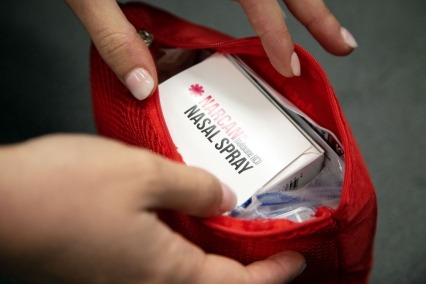
To address the overdose crisis in the United States, the National Institutes of Health has established a research network that will test harm reduction strategies in different community settings to inform efforts to help save lives. The harm reduction research network’s efforts build on existing harm reduction research, and represent the largest pool of funding from NIH to date to study harm reduction strategies to address overdose deaths.
More than 107,000 people in the United States died from a drug overdose in 2021, according to provisional data from the U.S. Centers for Disease Control and Prevention. These deaths are largely driven by the proliferation of cheap, potent synthetic drugs like fentanyl contaminating the drug supply, including in heroin, cocaine, methamphetamine, and counterfeit pills.
Harm reduction is an evidence-based, often life-saving approach that directly engages people who use drugs to prevent overdose, disease transmission and other harms. Researchers will test strategies to connect enrolled participants who use drugs with services and treatments and measure the effectiveness of these interventions in reducing overdose deaths and other outcomes.
“Getting people into treatment for substance use disorders is critical, but first, people need to survive to have that choice,” said National Institute on Drug Abuse (NIDA) Director Nora D. Volkow, M.D. “Harm reduction services acknowledge this reality by aiming to meet people where they are to improve health, prevent overdoses, save lives and provide treatment options to individuals. Research to better understand how different harm reduction models may work in communities across the country is therefore crucial to address the overdose crisis strategically and effectively.”
Funded by the NIH Helping to End Addiction Long-term Initiative, or NIH HEAL Initiative, through NIDA, the awards are expected to total approximately $36 million over five years, pending the availability of funds. Studies will enroll participants to investigate a range of harm reduction approaches, such as distributing naloxone, a lifesaving medication to reverse overdose, and fentanyl test strips, which people can use to determine if drugs are contaminated with fentanyl.
The research network will also examine the efficacy of moving harm reduction services and tools into communities via mobile vans, peer support specialists, internet- and smartphone-based tools and other types of outreach. By offering these services, harm reduction may be a first step interaction that also helps people access treatment for addiction and other healthcare.
Novel forms of harm reduction services may prove helpful in rural areas of the country, where people may need to travel long distances to receive care and services. According to 2020 CDC data, rural counties experienced 26.2 overdose deaths per 100,000 people, which was only slightly lower than the rates in urban counties (28.6 deaths per 100,000 people); overdose deaths involving psychostimulants were higher in rural counties than in urban counties from 2012 through 2020. Additionally, several projects will be aimed at populations disproportionally affected by the negative impacts of drug use, including Black and Latino/Latina communities, and women.
“The opioid and overdose crisis continues to evolve in dangerous and unpredictable ways, but scientific solutions that embrace innovative research and community connections offer the best hope for saving lives across America,” said NIH HEAL Initiative Director Rebecca G. Baker, Ph.D.
The new harm reduction research network will include nine research projects and one coordinating center. Grantees will investigate harm reduction strategies for their effectiveness in preventing drug overdoses and other adverse outcomes, sustainability and level of individual and community engagement. All projects will have a community advisory board and/or people with lived experience will have paid positions to support the research. Leading institutions and their projects include:
- Johns Hopkins University, Baltimore: Evaluating the impact of mobile van-delivered harm reduction services on overdoses among women in Baltimore who use drugs. Mobile vans will offer participants supplies like naloxone, fentanyl test strips and necessities such as food and clothing, brief trauma-informed counseling, and referrals to drug treatment, medical care and social services.
- New York University School of Medicine, New York City: Investigating the effects of a harm reduction intervention delivered via mobile van to Black and Latino/Latina participants who use drugs in New Haven, Connecticut, and the borough of the Bronx, New York. A community-based care coordinator will assess the unique needs of each participant (such as housing, food assistance, and mental health treatment) and then link them to appropriate services.
- Oregon Health and Science University, Portland: Evaluating two interventions – contingency management, an evidence-based behavioral intervention for the treatment of a variety of substance use disorders, and the identification of personal harm reduction goals with the support of a peer with lived experience – at community-based organizations in rural Oregon to increase the availability and effectiveness of harm reduction services for people who use methamphetamine.
- Research Triangle Institute, North Carolina: Assessing the reach, effectiveness, adoption, implementation, and maintenance of harm reduction services in San Francisco, with the goal of helping public health agencies, community-based organizations, and policy makers better understand how to tackle health-related harm among people who use drugs.
- Research Triangle Institute, North Carolina: Establishing a harm reduction research network coordination center that will provide support to the nine research studies in the harm reduction research network.
- University of Chicago: Measuring the use of harm reduction services and investigating how to successfully implement remote harm reduction strategies in rural Illinois communities. For instance, examining “secondary distribution” approaches, in which people who obtain harm reduction supplies (e.g., naloxone or fentanyl test strips) from harm reduction service providers share them with other people who use drugs who are currently without access to these providers.
- University of Nevada-Reno: Testing ways to identify and support “overdose responders” (people who use drugs who respond to overdoses in their peers), to better understand barriers to naloxone use and increase long-term use of naloxone among people who use drugs.
- University of Pittsburgh: Developing and testing an intervention aimed at changing behaviors and reducing risks among Black people who use drugs who visit the emergency department in Pittsburgh. The intervention, which will be delivered to participants by peers with lived experience of drug use, bundles evidence-based harm reduction strategies including take home naloxone and fentanyl test strips.
- University of Wisconsin-Madison: Developing and testing an intervention consisting of up to four internet- and smartphone-based tools designed to improve access to harm reduction services for hardly reached people, enrolling participants in both urban and rural regions of Wisconsin.
- Weill Medical College of Cornell University, New York City: Determining where and how to best provide mail-delivered harm reduction supplies by investigating the barriers to mail-delivery of harm reduction supplies, predictors of use and long-term engagement with mail-delivered harm reduction services and preferences of study participants who use them.
NIH is not providing funds for the purchase of pipes, syringes or needles.
The new harm reduction research network joins other ongoing harm reduction research funded by NIDA and the NIH HEAL Initiative, which address drug overdoses, drug use, transmission of HIV and hepatitis C, and intersectional stigma. NIDA and the NIH HEAL Initiative also fund substantial research on drug use and addiction prevention, diagnosis, treatment, and recovery support.
For more information on substance and mental health treatment programs in your area, call the free and confidential National Helpline 1-800-662-HELP (4357) or visit www.FindTreatment.gov.
Helping to End Addiction Long-term and NIH HEAL Initiative are registered service marks of the U.S. Department of Health and Human Services.
About substance use disorders: Substance use disorders are chronic, treatable conditions from which people can recover. In 2020, over 40 million people in the United States had at least one substance use disorder. Substance use disorders are defined in part by continued use of substances despite negative consequences. They are also relapsing conditions, in which periods of abstinence (not using substances) can be followed by a return to use. Stigma can make individuals with substance use disorders less likely to seek treatment. Using preferred language can help accurately report on substance use and addiction. View NIDA’s online guide.
About the National Institute on Drug Abuse (NIDA): NIDA is a component of the National Institutes of Health, U.S. Department of Health and Human Services. NIDA supports most of the world’s research on the health aspects of drug use and addiction. The Institute carries out a large variety of programs to inform policy, improve practice, and advance addiction science. For more information about NIDA and its programs, visit www.nida.nih.gov.
About the NIH HEAL Initiative: The Helping to End Addiction Long-term® Initiative, or NIH HEAL Initiative®, is an aggressive, trans-NIH effort to speed scientific solutions to stem the national opioid public health crisis. Launched in April 2018, the initiative is focused on improving prevention and treatment strategies for opioid misuse and addiction, and enhancing pain management. For more information, visit: https://heal.nih.gov.
About the National Institutes of Health (NIH): NIH, the nation’s medical research agency, includes 27 Institutes and Centers and is a component of the U.S. Department of Health and Human Services. NIH is the primary federal agency conducting and supporting basic, clinical, and translational medical research, and is investigating the causes, treatments, and cures for both common and rare diseases. For more information about NIH and its programs, visit www.nih.gov.
NIH…Turning Discovery Into Health®



